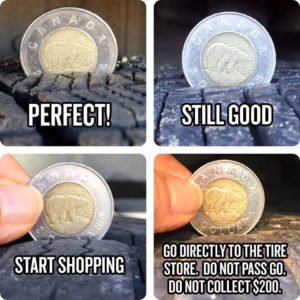Frequently Asked Questions
To find the right tire for your needs, think about these things…
What weather conditions do I drive in? Where will I be driving? City streets, long highways, field, off-roading, rural gravel? What is your driving style: Do you like to feel every curve or be cushioned from the road? Answering these questions will help our sales representatives determine your tire needs.
You can find your tire size in your vehicle owner’s manual or on the tire information sticker on your driver’s side door. If you are unsure, just bring in your vehicle and let us determine the size for you.
We provide a variety of tires that come in a wide range of prices. We sell new and used tires of varying performance rates from a number of different brands. Contact us if you would like a quote.
Generally, tires can lose approximately 1PSI every month. Therefore, it’s a good idea to check your tire pressure every month. Be sure to check it before leaving on a trip or when there are extreme temperature changes. To find out what your tire pressure level should be at, take a look at the tire information sticker along your driver’s side door.
Without regular rotations, tire treads can wear down unevenly to create a rough and potentially unstable driving surface. You paid good money for those tires, so it’s a good idea to take care of them. If you wait too long, your tires can develop a permanent wear pattern that can create a rough, noisy ride and will reduce the life of your tires. Be sure to rotate your tires every 8,000-10,000 km to keep them running smoothly and safely.
Each time new tires are installed and regularly thereafter, your tires should be balanced. Check the owner’s manual for your vehicle to see how often this should be done. Unbalanced tires will create an uncomfortable driving experience by creating vibrations in the steering wheel, making steering more difficult and delaying the response time of the steering wheel. Uneven tire wear can also be caused by unbalanced tires. The shocks, springs, bearings, and other components of the wheel assembly are under a lot of stress when the tires are not balanced, so they will experience more wear-and-tear than normal. If the unbalanced tires are not fixed in a timely manner, you will be replacing more than just the tires.
In extreme cold temperatures, the tread rubber of an all season or summer tire stiffens and becomes less able to provide sufficient traction. To combat this, tread rubber compounds of winter tires are designed to remain flexible, allowing the tire to grip the road better.
All-Season Tires are great for our fluctuating Canadian weather. However, All-Season have a finer tread and therefore, are designed for temperatures above 7ºC and not fit for snow and slush.
All-Weather tires on the other hand, will do well in heavy rain, slush and some snow. The rubber compounds in this type of tire are appropriate for mild winter temperatures above or below 7ºC.
Talk to a sales associate today to see what type of tire is right for you.

If you have space to store your tires, we will gladly bag up your tires for you to take with you. We have limited availability to provide for customer seasonal storage. Ask a sales representative regarding vacancies and storage fee.
NitroFilled tires are filled with impurity-free nitrogen instead of regular air. They will maintain air pressure longer, resulting in better fuel economy and longer tire life. It can take several months for a NitroFilled tire to lose a single pound of pressure compared to a typical air-filled tire that will lose 1-3psi per month.
Arnco’s patented* liquid polyurethane polymer is a product that is pumped into the tire through its valve stem. This flatproofing technology replaces all of the air and cures to a resilient, synthetic rubber core in 24 hours. It rides like air, reduces shocks and strains and is OEM approved. Arnco flatproofing completely eliminates flats and eliminates the need to monitor tire pressure. It is ideal for slower speed, light-duty equipment tires such as those used on mowers, golf and utility carts, power wheelchairs and roofing equipment.
